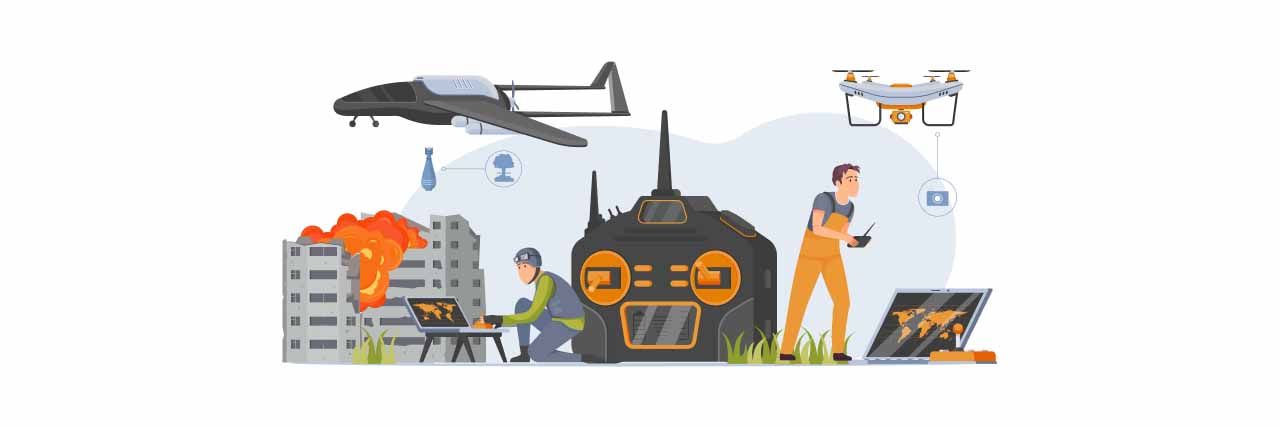In recent years, drone technology has advanced rapidly, especially in military applications, where its high mobility and low cost have reshaped modern warfare. However, drones are not limited to military use. From logistics and agriculture to smart city development, drones are increasingly integrating into daily life and various industries.
Below we will be exploring the drone industry, explore its latest developments, and analyze investment opportunities in Taiwan’s drone-related stocks.
What Is a Drone?

A drone, or unmanned aerial vehicle (UAV), is an aircraft that operates without a human pilot on board. It can be controlled remotely, guided autonomously, or operate using AI-based autopilot systems. Drones were initially developed for military purposes, where their unmanned nature made them ideal for reconnaissance missions, reducing risks to human personnel. With advancements in aerospace technology, drones have expanded into civilian applications, including package delivery, agricultural monitoring, and disaster response.
Drones equipped with cameras, commonly referred to as "aerial photography drones," are widely used for landscape photography, architectural surveying, and media production. In recent years, the drone market has grown rapidly, becoming an essential technology for governments, businesses, and individuals across industries such as construction, energy, agriculture, and emergency response.
Applications of Drones
| Industry | Primary Uses | Advantages |
|---|---|---|
| Logistics & Delivery | Rapid transportation of goods, avoiding traffic congestion, ideal for remote areas | Fast, labor-saving, accessible to hard-to-reach locations |
| Agriculture | Spraying pesticides, monitoring crops, improving efficiency while reducing costs | Precise application, resource-efficient, high safety |
| Security & Rescue | Surveillance, search and rescue, quick response to emergencies | High mobility, enhanced safety, adaptable to various environments |
| Mapping & Surveying | Rapid map creation for urban planning, research, and environmental monitoring | High efficiency, cost-effective, accurate data |
| Live Streaming & Media | Aerial filming for broadcasts, advertising, and news reporting | Unique perspectives, enhanced viewing experience, real-time streaming capability |
| Military & Defense | Reconnaissance, battlefield strikes, electronic warfare support | Reduces personnel risk, long-duration surveillance, rapid strike capability |
The Drone Industry Landscape

According to market research from Drone Industry Insights, the global drone market is expected to continue growing, reaching $54.6 billion between 2025 and 2030, with a compound annual growth rate (CAGR) of 14.3%.
Nvidia CEO Jensen Huang and TSMC Chairman have both expressed strong confidence in the future of the drone industry. Huang has even identified drones as one of the three most promising "robot-like" technologies for mass production.
In the military sector, countries such as the U.S., China, and Israel are heavily investing in drone technology, making drones an essential component of modern warfare. In commercial applications, companies like Amazon and UPS have already begun testing drone deliveries.
Leading Global Drone Companies
| Company | Key Business Areas |
|---|---|
| DJI (China) | Shenzhen-based DJI dominates the global drone market, holding approximately 70% market share. Its products span consumer, commercial, and professional applications, widely used in aerial photography, surveying, agriculture, and industrial inspections. |
| Skydio (U.S.) | Known for its advanced autonomous flight technology, Skydio focuses on high-end commercial drones, particularly for security, inspections, and government use. |
| Parrot (France) | Specializes in consumer and professional drones for imaging, mapping, and agriculture, and collaborates with European military agencies on tactical drones. |
| AeroVironment (U.S.) | A key supplier of military and commercial drones to the U.S. Department of Defense, specializing in small reconnaissance and tactical UAVs. |
| Insitu (U.S.) | A Boeing subsidiary that develops military and commercial drones. Its ScanEagle series is widely used for intelligence, surveillance, and reconnaissance (ISR), favored by military and government agencies. |
AI-Powered Drones
Nvidia sees drones as a critical sector and has made significant investments in AI-driven drone technology. The company’s Jetson platform, designed for edge computing, allows drones to run AI models directly on the device without relying on cloud-based processing.
Edge computing enables drones to process data autonomously, enhancing navigation, tracking, and environmental awareness without requiring continuous internet connectivity.
This makes drones more efficient in autonomous flight, object detection, and real-time response, further expanding their potential applications.
Taiwan’s Drone-Related Stocks
Taiwan’s drone industry has been rapidly growing, supported by government policies and increasing global demand. In September 2024, Taiwan’s Ministry of Economic Affairs established the "Taiwan Excellence Drone Overseas Business Alliance" to promote international expansion.
Taiwanese companies are actively developing military, logistics, agricultural, and surveillance drones. Below are some key Taiwan-based drone-related stocks:
| Company | Primary Business |
|---|---|
| Thunder Tiger (8033) | Taiwan’s leading drone manufacturer, specializing in military and commercial UAVs. It has secured defense contracts and participates in international military drone projects. |
| Aerospace Industrial Development Corporation (2634) | Primarily focused on aerospace manufacturing, AIDC has expanded into drone development, including anti-drone systems. |
| Coretronic Corporation (5371) | Its smart robotics division is actively involved in drone research, securing military contracts and expanding into commercial surveillance applications. |
| Evergreen Aviation (2645) | Originally focused on aircraft maintenance and manufacturing, EVA Air Aerospace has ventured into drone development, supplying naval reconnaissance UAVs. |
| Air Asia (2630) | Collaborates with Taiwan’s defense sector to develop military drones, including medium-to-large UAV designs. |
| MiTAC Information (Unlisted) | Specializes in cybersecurity and smart monitoring systems, providing backend support for drone data processing and flight control. |
| Taiwan UAV (Unlisted) | One of the few Taiwan-based company specializing in complete drone design, manufacturing, and integration, with military and government contracts. |
| GEOSAT Aerospace (Unlisted) | Focuses on drone R&D and manufacturing, offering solutions for agriculture, environmental monitoring, and defense applications. |
Taiwan’s drone industry is thriving, with companies not only targeting military markets but also expanding into commercial and surveillance applications. With government support and rising global demand, these stocks have strong growth potential.
Investment Risks & Opportunities
Market Challenges & Competition
The global drone market is highly competitive, with Taiwan’s companies facing challenges from U.S. and Chinese manufacturers.
DJI (China) dominates consumer and commercial drone markets, while U.S. firms like Skydio and AeroVironment continue to lead in high-end commercial and military UAVs. For Taiwanese companies to compete globally, they must focus on brand recognition, innovation, and strategic partnerships.
Additionally, regulatory restrictions vary across countries, particularly in military and commercial drone exports. Compliance with international trade laws will be crucial for Taiwanese drone manufacturers. Moreover, Taiwan’s domestic market is relatively small. Without effective access to international markets, the growth of the drone industry will be limited.
Growth Drivers
The integration of AI and 5G will continue to expand drone applications. In smart cities, drones could be used for real-time traffic monitoring, infrastructure mapping, and environmental surveillance. Logistics companies like Amazon and UPS are actively testing drone delivery systems, potentially paving the way for large-scale commercial adoption.
Taiwan's strength in semiconductors and ICT (information & communication technology) provides a solid foundation for drone innovation. Companies like MediaTek (low-power chips for navigation) and Asia Optical (high-end optical lenses) contribute essential drone components.
Government policy support is also one of the key drivers of growth. The Taiwanese government continues to promote military and commercial drone projects through tenders, while offering subsidies and fostering industry alliances to help companies accelerate development. If Taiwan can further deepen supply chain integration and strengthen international collaboration, the drone industry still has the potential to find a niche in the global market and enhance its competitiveness.
Conclusion
Taiwan’s drone industry has a strong foundation in key component manufacturing but still faces challenges in brand recognition and global competition. While the industry is growing, market success will depend on supply chain integration, government support, and international collaboration. If these factors align, Taiwan could carve out a niche in the global drone market.
